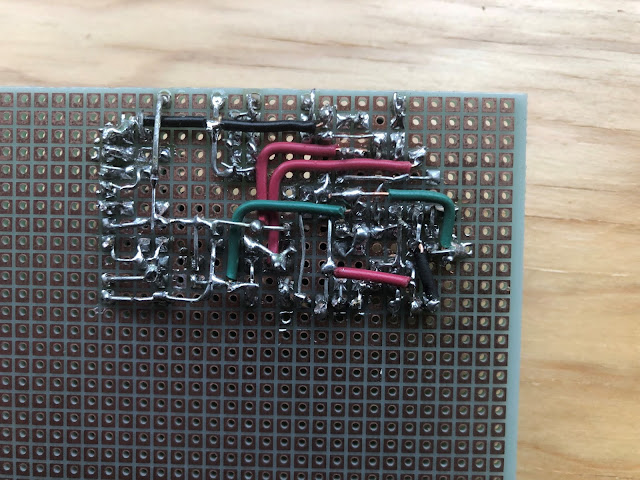This is my raised bed vegetable garden, designed to keep out nature's little Dr. Lecters. We have a herd of deer, a gang of woodchucks, a squirrel riot and a insurgent army of chipmunks that will fight a dog over a bone. I don't know if this will work or not, but it's a try. Check it out, the sides open on hinges:
Eye hooks with bungee cords hold the doors closed, necessary because this thing is built to such loose tolerances that I am ashamed. I guess the idea was (there was an idea) that it would be easily disassembled and loosely coupled so it would go pretty much anywhere and hang together. In that respect I guess I succeeded. I guess.
It started as a box of 1x12 #3 cedar, 8 feet by 4 feet (or so). It was important to keep the long side exactly 8 feet because so much of the wood is on those sides, so the short sides are butted in between the long sides and cut a couple of inches shorter so that half-lengths would span it. The mesh is 1/2" galvanized 19 gauge "hardware cloth". It doesn't remind me of hardware and it's nothing like cloth but what can you do - that's what they call it. This is the floor that stops the woodchuck from digging up through the bottom.

I leveled it in the yard somewhat, but not completely. That's important, because I should have leveled it perfectly. Why did I not? Well, why do I do anything? For some reason on the day I was doing this I decided it was good enough, not really thinking through the concept of swinging doors that would want to be level, and how that would match an off-kilter base. I think it's because I was facing the task of dumping 1.2 yards of topsoil into this with a wheelbarrow and a car ramp, and I got everything all mixed together in my head.
There you go, almost ready for dirt.No, wait, don't do it! What if I filled it up now and then I want to drive my U-posts into the corners and they hit a big rock and I had to dig the whole corner out? Or, worse, move the whole frame because the rock was too big? First I need to put in the posts.
Posts and dirt. I bent the flanges on the posts because I want them to go right into the corners.
That's a good one. It looks great. The face of the post is right up against the box corner so that when I face the U-post with a 1x3 cedar plank the bottom of the plank will be flush with the wood of the box, and therefore the door will close with no gaps. Sounds great but the fact is that this post is not completely vertical, so when I goof around with it to get it more vertical it will open up a gap down there. But probably no bigger than the 1/2" of the fence I'll be using.
A door. 4 by 8, the reason I fought to make sure the box was exactly 8 feet long all the time. So I wouldn't have to cut those long boards at all. The verticals are just a 1x3 cut in half.
Fastened with stainless wood screws. The long end is going up to the left.
Then a strip of 1x2 cedar is used to make the short sides flush, plus secure the mesh as well and hide the bitter nasty cut ends from the door user.
In my imagination this board would be flush with the face of the box. Imagination is a wonderful thing, but actual thinking would be better.This is a 1x3 board bolted to a U-post in the corner. That's the reason for the U-posts instead of T-posts - they have 1/4" holes in them every 6 inches or so, making it easy to attach things to them.
That's the four 8 foot 1x3 cedar boards stuck to the corner U-posts. That's a 1x6 cedar board perfectly level at a distance above the box that will allow the 4' x 8' door fully cover the opening. I attached it with a longer bolt through the U-post and the vertical face board. However in two of the cases, the horizontal board actually fell between two pre-existing holes in the U-post, and I had to make new ones. It's only mild steel, but it gave me a hard time. Plus I had to drill in place, which is always fun.
Hinge detail. These went on easily, but that's mostly because this a high-tolerance situation. See how the 1x6 bolted across the face boards becomes a header for the T-hinge? So the door in theory is flat, thanks to those 1x2 strips, and has a flat place to get flush against. Except for reality of course.
Reality intrudes in the form of the gap at the foot of the face boards where they touch the box, as I said. It intrudes in the form of a bulge in the side of the box, presumably from the weight of the soil. Basically the door corners don't want to go flush, so we encourage them with some biggish eye hooks and some rubber bungee cords.
There's two tomato plants, some climbing cucumber (they climb?), broccoli, cauliflower, celery and hopefully some romaine. Who knows, it's going to be a veggie brawl in there and I've never done this before. I guess we can throw some deer netting over the top. We could put another course of mesh around the sides if we need more height for the tomatoes...
Who knows
what's going to happen.
























